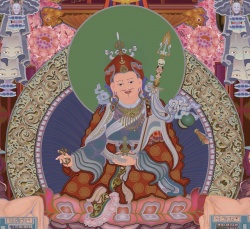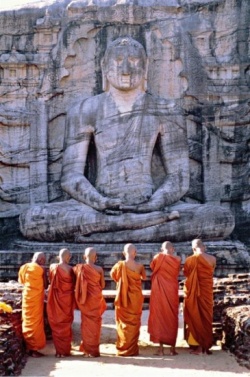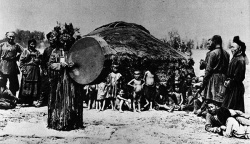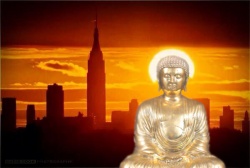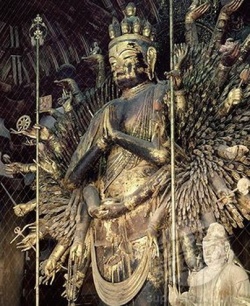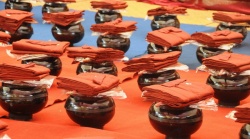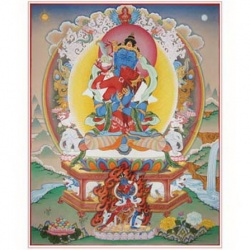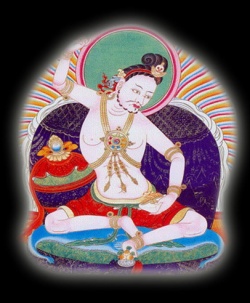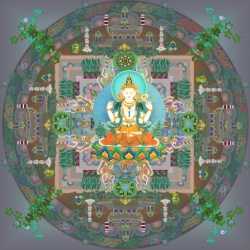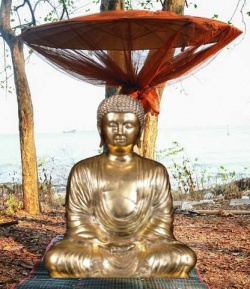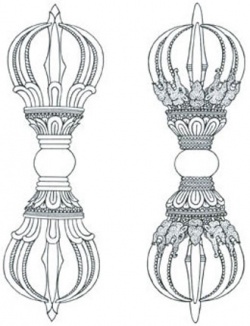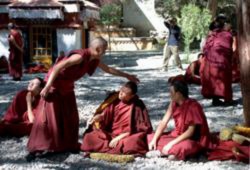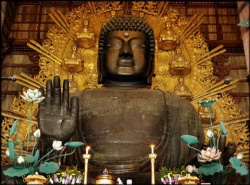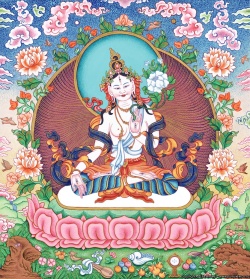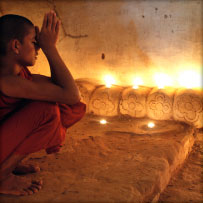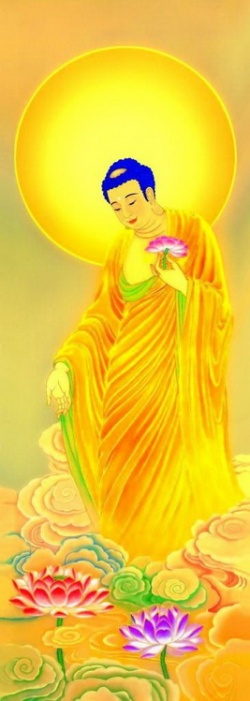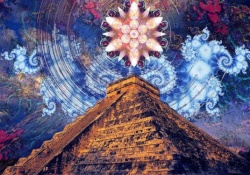The magic of consciousness: an inquiry into the concept of object in Yogacara buddhism
by LIN CHEN-KUO
Vasubandhu, a fifth century Yogacara Buddhist philosopher, claimed that all beings are nothing but the subjective manifestation of consciousness. His philosophy, as known by the label "mind-only" (citta-matra) or "consciousness-only" (vijnanamatra), was criticized in both Buddhist and non-Buddhist circles. As recorded in the Vimsatika (The Twenty Verses), a philosophical debate on the issue of whether or not the existence of external objects can be denied might have occurred in Vasubandhu's lifetime. For realists, knowledge cannot be explained if the existence of an external object is not postulated; however, Vasubandhu would call into question that very postulate.
The debate between Vasubandhu and the realists not only was one of the most fascinating episodes in the history of Buddhist philosophy, but now attracts many modern scholars. In the critical attempt to re-examine the whole story, they ask rather whether external objects really are denied in Vasubandhu's philosophy. They contend that what truly concerns Vasubandhu is not to deny the external world, but merely to disclose our misconception about this world. For those scholars, the traditional interpretation of Yogacara philosophy as "idealism", in the sense of denying external objects, truly throws out the baby with the bathwater.1
By taking the above ancient and contemporary controversies into consideration this paper attempts to examine a Yogacara concept of object with particular reference to Vasubandhu's two treatises, Trimsika (The Thirty Verses) and Vimsatika.2 The first two parts of this paper will summarize Vasubandhu's basic ideas of "perception only" and consciousness, and his response to the realist critique. The third part will explain how an object is constituted through a "transformation of consciousness" (vijnana-parinama). Then, it will discuss the problem of the certainty of knowledge in the context of Vasubandhu's philosophy. The final part will review Vasubandhu's philosophical task with some critical remarks.
PERCEPTION-ONLY (VIJNAPTIMATRA) AND THE
REALIST CRITIQUE
In the beginning of the Vimsatika, Vasubandhu stated his philosophical position as follows: "The three realms (traidhatuka) are vijnapti-matra (perception-only)." As a central point of controversy, the term vijnapti-matra not only was mistreated by Vasubandhu's contemporaries, but also caused trouble for modern scholars. Various renditions of it have been provided, such as "consciousness-only," "ideation-only," "representation-only," "perception-only," etc., but none of them could be of much help without the whole argument being fully articulated. Meanwhile, we need to know only that the term vijnapti literally means "proclamation" or "making known," and that the term matra means "only."3 As a compound, vijnapti-matra in the present context means "being known or presented [in the consciousness] only."4 The whole statement means that the entire universe, which consists of the realm of desire (kamadhatu), the realm of form (rupa-dhatu) and the realm of formlessness (arupya-dhatu), are nothing but that which is known or presented within consciousness. "Only" is stressed in order to rule out any external referent or object (artha).
This "idealist" statement invited immediate objections from realists:
(1) If perception occurs without referring to an external object, then there could be no determination of space and time. But then why does the perception of a certain thing occur only at a specific time and place, not anytime and anywhere? If perception arises from the consciousness without referring to any external object, then one could perceive, for instance, a table anywhere and anytime. But, in fact, consciousness is not thus arbitrary. Therefore, the existence of an external object is necessarily required for the occurrence of perception.
Vasubandhu replied that in the case of dream a perception does occur at a specific time and place, though this does not correspond to any external object. For example, I had a dream that in the morning I saw Mr. Wang on the corner of a street. In this case time and space are determined even when Mr. Wang is nonexistent.
(2) Realists raised another question: If perception occurs without corresponding to an external object, why is it that many persons present at the specific time and space are able to have the same perception of something? In other words, if the perception depends on the consciousness only and not on the external object at all, then that specific perception could not be manifest to all observers who are present at the same time and place. But this is not the case, for all drivers can see the red light when they stop in front of the traffic light. If this is true, then there must exist a real red light corresponding to the driver's perception.
Vasubandhu replied that common perceptions can occur without referring to an external object because observers share the same structure of consciousness. Vasubandhu gave an example of hell and hungry ghosts (which was popular and suitable for his contemporaries), saying that all hungry ghosts living in hell see the pusriver and the hell-guardians that in fact are nonexistent since they fall into hell because of the maturation (vipaka) of the same deeds (karma). According to the Buddhist tradition, the world of life-and-death is constituted by the experiences of those who share the same kind of karma in the past. Thus the structure of individual consciousnesses is supported by a common past. The Yogacara coined a technical term, vikapa-vijnana (maturation-consciousness) to designate this underlying structure of consciousness which results from the maturation of past deeds.
(3) The most striking criticism from realists is the problem of efficacy. If perception in the waking state is the same as that in a dream, so that all perceptions do not correspond to external objects, then why does the thing perceived in the waking state have efficacy whereas that in a dream does not? For instance, the poison and knife in a dream do not possess the function of killing, while in the waking state they do.
In response to this criticism, Vasubandhu did not deny the efficacy of things and actions, but argued that efficacy is exactly prompted by perception-only without necessarily relying on an external object as its cause. A good example is a wet dream in which sexual excitement can be aroused by a sex partner who in fact is nonexistent.
Up to this point, Vasubandhu defended his position quite satisfactorily by arguing that the three pillars of realism, i.e., determination of time and space, indetermination of observers, and efficacy, cannot prove the existence of external objects because they occur also in situations in which no external object exists. Vasubandhu admitted the above three conditions of experience. However, he did not accept the realist's theory, but argued that what is experienced or perceived is perception-only (vijnapt-matra).
That Vasubandhu successfully presented counter-arguments to the realist's criticism is not equivalent, however, to saying that his own position is demonstrated. The problem remains. Both in waking and in dreams we do have a perception of something. How is it possible that "something" does not exist independently of consciousness; or how is it possible that "something" exists as manifested by, and to, consciousness above? The clue to an answer to this question is found in Vasubandhu's doctrine of consciousness.
VASUBANDHU'S DOCTRINE OF CONSCIOUSNESS
In early Buddhism, consciousness (vijnana) is analyzed into six categories: five sense-perceptions (seeing, hearing, smelling, tasting and touch) and mental-perception (mano-vijnana).5 These perceptions arise when the two conditions, sense-faculties (indriya) and their respective sense-objects, are present. For instance, a visual perception arises when eyes and something visible (rupa) are had; similarly mental perception arises when there is a mind (mano) and a mental object (dharma). The sum of six perceptions, including sensory and mental perception, are named "consciousness".
As conditions of perception, the five sense-faculties and the five sense-objects have never been examined as to their ontological status, but according to the early Buddhist scriptures they were considered to be real. Now, Yogacara claims that both sense-faculties and sense-objects are merely manifestations (pratibhasa) of consciousness: they are merely perception without referring to external objects.6 How does Yogaraca justify such a deviation from the Buddha's original teaching?
In addition to the sixfold structure of consciousness, Yogacara added two more layers: the store-consciousness (alaya-vijnana) and the ego-consciousness (manas) so that in total consciousness becomes eightfold. Note that this sort of classification is purely typological and cannot be interpreted literally as meaning that there are eight consciousnesses.
First, let us look at the notion of "store-consciousness" (alaya-vijnana). Etymologically the word alaya is derived from the verb root a-li, meaning "come close to, to settle down upon, to stoop." Thus it means "a house, a dwelling, a receptacle."7 It also means "clinging" or "that to which one clings." Accordingly, alaya-vijnana is usually translated as "storehouse-consciousness" and means a latent consciousness which functions like a storehouse where the "seeds" (bija) of the previous actions (karma) and cognition are deposited. In this sense, "store-consciousness" is taken as synonym of "consciousness-containing-all-seeds" (sarvabijakavijnana).
According to the Samdhinirmocana-sutra (SNS), a fourth century Yogacara text, the store-consciousness is characterized by two kinds of appropriation (upadana): (1) "to sustain" the sense-faculties, and (2) to appropriate the psycholinguistic sediments (vasana) which result from the daily discourse.8 In the SNS, the ontological status of body is not doubted, probably because there the doctrine of perception-only has not yet fully developed. But we will see later that in Vasubandhu's philosophy the notion of "body" is nothing but the perception or consciousness of body: the inner consciousness of body is the base of body.
The store-consciousness consists of all sorts of "seeds," a metaphorical notion which needs further exposition. Although the notion of "seed" can be traced back to the Nikaya and Agama literature, it was directly inherited by the early Yogacara thinkers of the Sautrantika school.9 They contended that when the action (karma) momentarily perished it "perfumes" (vasana) the consciousness-stream (cittasamtana), creating thereby a special potentiality. This potentiality ripens through a period of the evolution in the consciousness-stream.10 As a result, through the perfuming of action a "seed" is transformed into a "sprout" and finally turns into a "fruit".
By adopting this mode of metaphorical thinking, the early Yogacarins viewed the store-consciousness as the "container" of all karmic and psycho-linguistic "seed". In given conditions, a "seed" can be actualized and transformed into an object-in-perception which, in turn, by the activities of the other seven consciousnesses, leaves its residual force in the store-consciousness. In the sixfold perceptions there exists a cycle of mutual causation: the object-in-perception results from the actualization of "seed", and conversely the "seeds" result from the perfuming activities of the sixfold perceptions.
But what are "all seeds" in the store-consciousness? Theoretically the notion of "seeds" must be comprehensive enough to account for the formation of all things perceived and experienced. As seen in Asanga's Mahaynasamgraha, a Yogacara text written earlier and commented upon by his half brother Vasubandhu, the "seeds" are divided into three categories, (1) those perfumed by discourse (abhilapavasanabija), (2) the conception of self (atmadrstivasanabija), and (3) the members of becoming (bhavangavasanabija).11 Those of category 2 cause the formation of ego-consciousness, those of category 3 cause rebirth, while those of the first category cause the all perceptions, including sense-objects and their respective sense-organs.12 For instance, as Vasubandhu explained, a "seed" of "eye" in the store-consciousness serves as the cause of eye, and so does a "seed" of "ear" serve as the cause of ear, and so forth.13
"Discourse" is constituted of both nominal and perceptual activities. Nominal activities are directed to the referent (artha) by means of sound and words, while perceptual activities make objects manifest to consciousness without utilizing sounds and words. Both are indispensable for daily discourse14 whose sediments or residuals in the store consciousness are called "seeds".
But how are the "seeds" as sediments of discourse in the store-consciousness transformed into all sorts of sensory and mental perceptions? That is, how is it possible for the Yogacara to claim that the objects of cognition and sense-organs are merely the manifestation (pratibhasa) of "seeds"? Vasubandhu attempted to solve this problem by introducing a new notion, i.e., "transformation of consciousness" (vijnana-parinama). This became the core of later Yogacara philosophy, though it had not been fully developed philosophically in Vasubandhu's lifetime.15
TRANSFORMATION OF CONSCIOUSNESS
In stanza IX of the Vimsatika, Vasubandhu utilized the notion of "transformation" to explain how the object of cognition arises:
Perception (vijnapti) is born from its own seed (svabija) and evolves (pravatate) into object-like appearance (abhasa). It is in this context that the Sage spoke of the twofold bases of cognition.
In his self-commentary, Vasubandhu explained further:
What does that stanza mean? That which is manifest (vijnapti) as the object-like visible (rupa-pratibhasa) arises from its own "seed" which, while other conditions are provided, has undergone through transformation (parinama) and thereby is differentiated (visesa). The Buddha spoke of the "eye" and the "visible" as the bases of cognition with reference to the seed and the object-like visible respectively. In the same way, that which is manifest as the object-like tactile arises from its own "seed" which, while other conditions are provided, has undergone transformation and thus been differentiated. The Buddha spoke the "body" and the "tactile" as the bases of cognition with reference to the seed and the object-like tactile respectively.16
In Buddhist philosophy, a sense faculty and a sense object are required for perception to arise. But what do these notions really mean? Can a sense organ, for instance, an eyeball, be taken as the cause of perception, or can we say that an eye sees a table? For Yogacara, the notions of "sense faulty" and "sense object", which had never been doubted, now are called into question.
According to Yogacara, a moment of perception ceases as soon as it arises. This notion of momentariness is essential to understanding Yogacara's concept of perception for between two moments of perception there must exist causal continuity. Since each perception arises and perishes momentarily, their causal continuity can be explained only if a third party exists. The notion of "seed" is introduced here to serve as that third party. Yogacara contended that each perception-moment "perfumes" and leaves its own sediment ("seed") in the store-consciousness which causes the next perception-moment to arise.
Vasubandhu tried to argue here that only the "seeds," as the sediments of the previous discourse and action, are qualified as the cause of the present perception. Rather than saying that "an eye sees a table," this statement should be paraphrased as: the present perception of "table" is caused by the "seed" of the preceding perception of "table". Rather than referring to an external object, the object of perception is transformed from the "seed" which is deposited in the store-consciousness.
To look closer at the notion of "seed," this can be understood analogically as a semiological code which was coded in the past. If certain conditions are provided, these will be decoded and appear on the screen in the form of appearance. Similarly, all perceptions in daily life are nothing but manifestations of those codes which are coded and deposited in the store-consciousness. (Since all codes are genetic and public, the store-consciousness is also genetic and intersubjective.)
This sort of genetic process in which codes are coded and decoded is called "transformation of consciousness" (vijnanaparinama). The purpose of Vasubandhu's philosophy is to disclose this indiscernible process of transformation. Vasubandhu further discussed this notion in the Trimsika. In its very first stanza, Vasubandhu claimed that whatever are designated as "things" (dharma) and "self" (atman) are merely transformations of consciousness. In the following 16 stanzas, Vasubandhu proceeded to explain how transformation occurs in each of the three layers of consciousness. By comparison to the opening statement in the Vimsatika, we see that in the Trimsike Vasubandhu clearly intended to demonstrate the truth of perception-only in light of this new idea of the "transformation of consciousness."
Derived from the root nam, meaning "to bend or bow, to subject or submit one's self, to turn towards, i.e., to aim at, to yield or give way," the term parinama means the transformation of one's self into something.17 As a compound, vijnana-parinama means that vijnana (perception/consciousness) is characterized essentially by the act of constituting/objectifying something. That "something" is the result of the transformation of that which perceives. Simply put, the object of perception is given (in the sense of "constituted") by perception itself. This process of object constitution is called "transformation".
In stanza 17 of the Trimsika, Vasubandhu further clarified the notion of vijnana-parinama as synonymous with vikalpa (constitution):18
The transformation of consciousness is constitution (vikalpa). What is constituted (yad vikalpyate) does not exist. Therefore, everything is perception-only (vijnaptimatraka). (Trimsika XVII)
According to Sthiramati's (ca. 470-550) commentary, vikalpa or cognitive constitution is the nature of the mind (citta) and its mental associates (caitta) belonging to all the three realms (tridhatuka). The constructions (adhyaropita) of mind are the various forms of objects (artha-akara) which do not correspond to external objects19 but are merely manifestations of "seeds".
In the next stanza, Vasubandhu explained how constitution (vikalpa) proceeds:
The consciousness contains all seeds; (its) transformations in such and such ways proceed through mutual influence. From this constitution arises. (Trimsika XVIII)
This stanza indicates that the constitution of an object is not transcendentally grounded. All are nothing but transformations of consciousness, occurring through the mutual causation between the store-consciousness ("seeds") and the sixfold perceptions. Depending on the "seeds", perceptions arise; and depending on perceptions, the "seeds" are perfumed. All objects are constituted in the closed circle of mutual causation in consciousness, outside of which no external object can be affirmed.
THE CERTAINTY OF KNOWLEDGE
Let us return again to the problem of the certainty of knowledge. For realists, the doctrine of perception-only has difficulty in explaining away the fact that in daily life we surely do, for instance, see and grasp a cup. If there does not exist a cup independent of consciousness, they argued, how can this certainty be justified?
Vasubandhu replied that he did not deny the certainty of knowledge and experience but that he does not agree to postulate external objects as the grounds of that certainty. Vasubandhu asked, how can the existence of an external object independent of consciousness be demonstrated? Obviously, for Vasubandhu, it is the realist's postulation of external objects which needs to be critically examined.
According to the previous analysis, we conclude that the discrepancy between Vasubandhu's and realist's positions lies in their different conceptions of consciousness. For realists, consciousness is like a mirror that correctly reflects things out there. Between the reflection (image) and the object there is a representative relationship. On the contrary, Vasubandhu viewed consciousness as constituting so that being conscious of something is tantamount to constituting and objectifying it: what is constituted (i.e., the object-in-consciousness) reflects that which constitutes (consciousness).
For Vasubandhu, to assert or postulate a corresponding or representative relationship between an object-in-consciousness and an external object is a "perverse view" of consciousness which is intersubjective. In the Trimsika and the Vimsatika, the store-consciousness is also called "consciousness-in-maturation" (vipaka-vijnana) for the store-consciousness results from the maturation of past deeds (karma): those who have done the same kind of deeds are born into the same world, and share the same structure of consciousness. Vasubandhu did not mention an a priori structure, but he did consider the present consciousness as the embodiment of the past. Due to this intersubjective consciousness, one perceives something in the same way as do the others.
Furthermore, as mentioned above, perception is directly caused by its own "seed" (semiological code) deposited in the store-consciousness. The reason why a certain perception appears in this rather than in another way, is due to the determination of "seed". Since the "seed" is essentially linguistic and conventional. It is due precisely to the linguisticality and conventionality of "seeds" that the certainty of perception is obtained.
WHAT IS THE REAL?
The last question is, "What is the real for Yogacara?" Though the Yogacara says that all are perception-only, ordinary people do not realize this truth. They name the thing which they perceive, and believe that the named or signified exists "out there". For Yogacara, the signified is mistakenly endowed with ontological status, though in fact it is nonexistent. Confined within, all sorts of nonexistent but signified constitute the world-construction of daily discourse. This discursive world is called "imagined" (parikalpita).
But this "imagined" conceals the reality which needs to be disclosed. As a closed system of consciousness in which the object-like appearance arises, this reality is called "dependent" (paratantra), meaning that the arising of an object depends on the cause and conditions. The "dependent" is the reality, but is defiled and in need of being purified or perfected.
Only if one is detached from the "imagined" and stays in the state of perception-only (vijnaptimatrata), realizing that all are nothing but vijnapti, is one able to achieve the perfected state (parinispanna). The final question is, does one have any knowledge of "external objects" in the perfected state, or are they still denied in this state? For Yogacara, as enlightenment means to stay in the realization of perception-only, i.e., the realization of emptiness, the enlightened one is not supposed to make any assertion about the existence of external objects.
CONCLUSION
Investigation of the nature of the object has been the focal issue in Vasubandhu's philosophy. Particularly as seen in the debate with realists, this issue is full not only of epistemological significance, but also of soteriological implications. To Vasubandhu, the realist's assertion of external existence obstructs the path of enlightenment and liberation.
Like any form of metaphysics, realism conceals more truth than it can disclose. Vasubandhu argued that object constitution is obscured by realism in the same way that the reality of the "dependent" is concealed by the "imagined". As far as one is directed towards the external world, one will inevitably ignore the subjective construction and fail to see how desire and power are involved in the assertion of external objects. To postulate or assert external objects is equal to making objects for grasping and desiring. For Vasubandhu, then, there is no pure epistemology or pure-science; to claim any sort of pure science or realism is absolute myth.
NOTES
1. Alex Wayman was probably the first to challenge the traditional label of Yogacara philosophy as "idealism". See Alex Wayman, "The Yogacara Idealism" (review article), Philosophy East and West, 15 (1965), 65-73; "Yogacara and the Buddhist Logicians", JIABS, 2 (1979), 65-78.
2. For textual sources, see "References".
3. Franklin Edgerton, Buddhist Hybrid Sanskrit Grammar and Dictionary, II, p. 485.
4. For an excellent discussion on this Buddhist technical term, see Bruce Cameron Hall, "The Meaning of Vijnapti in Vasubandhu's Concept of Mind", JIABS, 9 (1986), 7-23.
5. The term mano-vijnana has been rendered in various ways. K.N. Jayatilleke rendered it as "internal perception" or "introspection" in his Early Buddhist Theory of Knowledge (1963), p. 436. Walpola Rahula, another leading scholar in the field of early Buddhism, translated it by "mental consciousness". See his What the Buddha Taught (1959), p. 23.
6. Vimsatika, IX.
7. Monier Monier-Williams, A Sanskrit-English Dictionary, p. 154.
8. Chieh-shen-mi ching, T. 16.692.b; Etienne Lamotte, Samdhinirmocana Sutra: L'Explication des Mysteres (1935), pp. 55.
9. For a brief history of the notion of "seed", see Chen-Kuo Lin, "The Samdhinirmocana-Sutra: A Liberating Hermeneutic," unpublished Ph.D. dissertation (1991), pp. 127-128.
10. See Etienne Lamotte, "Introduction" to Karmasiddhiprakarana: the Treatise on Action by Vasubandhu, English translation by Leo M. Pruden (1988), p. 28; Yokoyama Koitsu, "Seshin no Shiki-teinpein," in Koza Daijobukkyo, vol. VIII, Yuishiki Shiso (1982), 119-120.
11. Asanga, Mahayanasamgraha, T. 31.137.b; E. Lamotte (1973), pp. 80-81.
12. See Vasubandhu, Mahayanasamgrahabhasya, T. 31.336.c; E. Lamotte (1973), pp. 80-81.
13. Vasubandhu, Mahayanasamgrahabhasya, T. 31.336.c.
14. See Wei Tat, Ch'eng Wei-Shih Lun, p. 582.
15. For a history of this technical term, see Yokoyama Koitsu, "Seshin no Shike-teinpein".
16. My translation is based on Hsuan-tsang's Chinese translation, but I have consulted also the Sanskrit text and modern translation. See Clarence H. Hamilton, pp. 35-37; Steven Anacker, p. 167; Thomas Kochumuttom, pp. 171-172; and Thomas Wood, p. 9.
17. Monier Monier-Williams, pp. 528, 594.
18. Franklin Edgerton, Buddhist Hybrid Sanskrit Grammar and Dictionary, p. 480: vikalpa, "(vain) imagining, esp. false discrimination between true and false, real and unreal."
19. Huo t'ao-hui, An-hui san-shih-wei-shih-shih yuan-tien i-chu (Sthiramati's Commentary on Trimsikavijnapti) (1980), pp. 111-113.
REFERENCES
A standard Sanskrit source used for Vasubandhu's Trimsika and Vimsatika is: Sylvain Levi, Vijnaptimatratasiddhi: Deux traité de Vasubandu, Vimsatika et Trimsika. Bibliotheque de L'Ecole des Hautes Etudes, 245 (Paris, 1925). Since this book is not available to me, I have used a text edited by Kizo Inazu: Bonkanwa Taiso Sechin Yuishikiron Genten (Tokyo, 1978). Inazu reproduced Levi's work and put Husan-tsang's Chinese translations side by side with the Sanskrit originals, which makes it very convenient. For Hsuan-tsang's Chinese translations, see also Wei-shih san-shih lun-sung (T. 31, No. 1579) and Wei-shih erh-shih lun (T. 31, No. 1590).
Anacker, Stefan. Seven Works of Vasubandhu: The Buddhist Psychological Doctor. Delhi: Motilal Banarsidass, 1984.
Chatterjee, K.N. Vasubandhu's Vijnapti-matrata-siddhi (with Sthiramati's Commentary). Varanasi: Kishor Vidya Niketan, 1980.
Edgerton, Franklin. Buddhist Hybrid Sanskrit Grammar and Dictionary, Vol. I and II (1953), Delhi: Motilal Banarsidass, reprint, 1985.
Hall, Bruce Cameron. "The Meaning of vijnapti in Vasubandhu's Conception of Mind," JIABS, 9 (1986), 7-23.
Hamiliton, Clarence H. Wei Shih Er Shih Lun (The Treatise in Twenty Stanzas on Representation-Only by Vasubandhu). New Haven: American Oriental Society, 1938.
Hattori, Masaaki. "Realism and the Philosophy of Consciousness-Only," Eastern Buddhist, XXI (1988), 23-60.
Huo, Tao-hui. An-hui san-shih wei-shih shih yuan-tien i-chu. Hong Kong: The Chinese University Press, 1980.
Kochumuttom, Thomas A. A Buddhist Doctrine of Experience. Delhi: Motilal Banarsidass, 1982.
Lamotte, Etienne. Samdhinirmocana Sutra, L'Explication des Mysteres. Louvain, 1935.
. La Somme du Grand Vehicule D'Asanga (Mahayanasamgraha). Louvain-la-Neuve, 1973.
. Karmasiddhiprakarana: The Treatise on Action by Vasubandhu. English translation by Leo M. Pruden. Berkeley: Asian Humanities Press, 1988.
Monier-Williams, Monier. A Sanskrit-English Dictionary. Oxford, 1899.
Schmithausen, Lambert. Alayavijnana: On the Origin and the Early Development of a Central Concept of Yogacara Philosophy. Tokyo: The International Institute for Buddhist Studies, 1987.
Ueda, Yoshifumi. Bukkyo Shisoshi Kenkyu. Kyoto: Nagata Bunshodo, 1972.
. Yuishiki Shiso Nyumon. Tokyo: Asoka shorin, 1964.
. "Two Main Streams of Thought in Yogacara Philosophy," Philosophy East and West, 17 (1967), 155-165.
Warder, A.K. "Objects," Journal of Indian Philosophy, 3 (1975), 335-361.
Wayman, Alex. "The Yogacara Idealism" (review article), Philosophy East and West, 15 (1965), 65-73.
. "Yogacara and the Buddhist Logicians," JIABS, 2 (1979), 65-78.
Wei Tat. Ch'eng Wei-Shih Lun: Doctrine of Mere-Consciousness. Hong Kong: The Ch'eng Wei-Shih Lun Publication Committee, 1973.
Wood, Thomas E. Mind-Only: A Philosophical and Doctrinal Daijobukkyo, VIII, Yuishiki Shiso. Tokyo: Shunjusha, 1982. Pp. 113-114.
